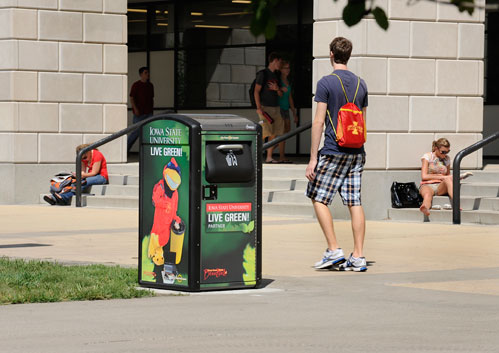Aug. 26, 2010

No, it's not a book drop.
Twelve new BigBelly solar trash compactors were permanently installed around campus this week. This one, south of Parks Library, is wrapped with scenes of studying and commencement. Each compactor displays a different theme, depending on where it's located. Photo by Bob Elbert.
Talking trash
by Paula Van Brocklin
One year after facilities planning and management initiated the BigBelly solar trash compactor pilot program, the number of compactors on campus has grown from one to 12.
Earlier this week, FPM employees began installing 11 new compactors in high-traffic areas across campus. Each compactor sports a different theme depending on where it's located. For example, the wraps, or photos, on the two new compactors near Parks Library show students studying and scenes from commencement. The locations and themes of the remaining nine compactors are:
- College of Veterinary Medicine -- animals
- Memorial Union -- zodiac
- Gerdin Business Building -- travel/study abroad
- Near Curtiss and Catt halls, and Jischke Honors Building -- science
- Hub -- music and VEISHEA
- Union Drive Community Center -- living green in the residence halls
- Campbell Transit Center, Iowa State Center -- CyRide
- Lagomarcino Hall -- bicycling
Good-looking and high-tech
The newest BigBellys not only are attractive, they're smart, too. Unlike the original compactor used during the pilot, each new compactor has a sensor that indicates when it's full via radio transmission. This information is sent to a website, which is monitored by FPM. Before, employees had to physically check on the compactor periodically.
Worth the money
The cost of each compactor, including the wrap, is about $5,000. FPM funded the project with year-end money. But considering the fuel saved in driving around campus to pick up garbage, Les Lawson, manager of facilities maintenance, thinks it's a good investment.
"Cost savings are tough to pin down," Lawson said. "But when the pilot compactor was near Curtiss about a year ago, we only had to dump it once per week versus standard trash cans, which had to be dumped once each day."
